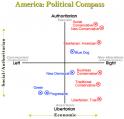The American Parliament: Our nation’s 10 political parties
 Part two in a series.
Part two in a series.
Forgive me for abstracting and oversimplifying a bit, but one might argue that American politics breaks along the following 10 lines:
- Social Conservatives
- Neocons
- Business Conservatives
- Traditional Conservatives (there’s probably a better term, but I’m thinking of old-line Western land and water rights types)
- Blue Dog Democrats
- New Democrats
- Progressives
- Libertarians: True
- Libertarians: American (Tea Party)
- Greens
There are points of overlap, obviously. In a pure parliamentary environment, these might hypothetically be ten distinct parties, or at least four or five. SocCons are defined by a fairly unitary range of religious concerns, and while they can easily make common cause with certain groups, economic issues are peripheral to their raison d’etre. Neocons and Business Conservatives (Country Club Cons) seem to overlap quite a bit and they appear to get on well with TradCons. The New Dems are functionally indistinguishable from Business Conservatives at this point in history, and the Blue Dogs might be thought of as New Dems with a healthy streak of SocCon running through them. There aren’t enough True Libertarians to shake a stick at, but the perspective is viable enough to be counted here. The American Libertarian/Tea Party is a strange brew driven by radical, race-inflected anti-tax and anti-government ideology. It has been heavily funded by BizCons, draws heavily on a bastardized understanding of the writings of Ayn Rand, and should never be confused with true Libertarianism.
Serious Progressives and Greens can be hard to tell apart – many Greens seem to be people who have given up on the utility of the Democratic party, and their official platform reads a lot like any strongly progressive mission.
If you’re familiar with the Political Compass, we might use that framework to express these positions graphically:

These ten different parties, such as they are, have to cram themselves into a two-party system, and the result usually shakes out this way:
- Republicans: Social, Business, Neo and TradCons, Libs and Tea Party
- Democrats: Blue Dogs, New Dems, Progressives and Greens
However, when it comes time to pass laws, order frequently break down. During the Bush years we saw a lot of Blue Dog and New Dem cooperation with the GOP, and under Obama we’re seeing the continued dominance of that “center/right” coalition, a practical result that frustrates progressives, especially in light of all kinds of polling showing that once you set aside labels and ask people to focus on what sorts of outcomes they believe in, the American public is far more supportive of progressive policies than is commonly understood.
The American Parliament
If we moved to a proportional parliamentary system (no, we’re not going to, not in a million years, but hypothetically) and shifted the coalition building process to the governing phase instead of the campaign/electoral phase, we might initially see the 10 hypothetical parties coalescing into a shape that looks something like this:
- Social Conservatives – significant enough numbers to go it as a distinct entity that can demand concessions on its core issues from all constituencies except the Progressives.
- NeoLiberal – the grand coalition of wealth-minded conservatives, New Dems and Blue Dogs, plus the Tea Party.
- Progressives – Progs plus Greens now have enough stroke to exert viable leverage on the legislative process.
- Libertarians – May choose to ignore social libertarianism completely and join Neos, but could decide to go it alone or to forge something with TradCons.
Page 1 of 2 | Next page